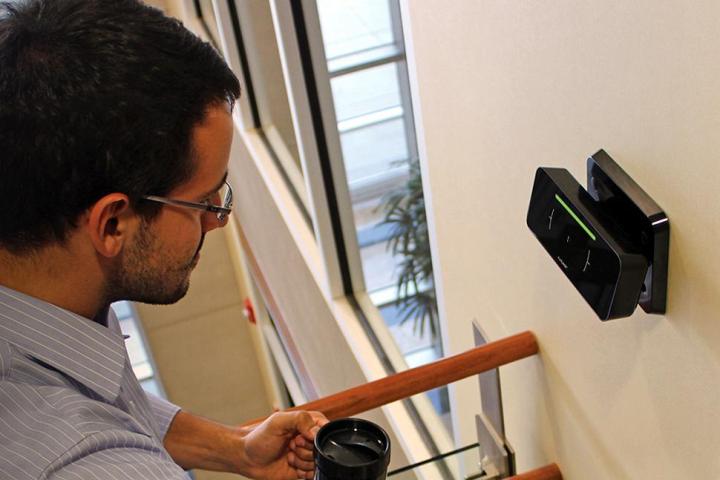
How it works
The iris, the ring of color around the pupil of each eye, is the most uniquely identifiable part of your body’s exterior (and much of its interior, for that matter). Most iris-scanning systems work by snapping a high-res photo of your eyes, isolating the iris portion of the image, then running that through a matching algorithm to see if you’re on the guest list. Like fingerprint matching, facial recognition software, and retinal scanning, iris scanning is a biometric technology that compares a person’s unique physical characteristics against a database to verify his or her identity. A positive match, or an “accept” in the tech lingo, can then trigger an event: the decryption of a top-secret document, the launch of a world-destroying weapon, or the unlocking of your bedroom door.
With a false-positive rate of just 1 in 1.5 million, the accuracy of a quality iris scan is bested only by a DNA sample.
With a false-positive rate of just 1 in 1.5 million, the accuracy of a quality iris scan is bested only by a DNA sample (which boasts an immodestly accurate rate of one in 800 trillion). The rate for fingerprints, by comparison, is a meager 1 in 10,000. And voice identification? A paltry one in 500. The cost of these biometric technologies maps pretty closely to their accuracy. If price isn’t a huge concern, iris scanning is the way to go.
It’s worth mentioning that iris scanning is similar to retina scanning, but it’s not the same thing. Retina scanning is an older technology that uses an image of the nest of blood vessels at the rear of your eyeball. Getting that image means waiting for the pupil to dilate and then shining a beam of light through it to illuminate the back of the eye before taking the picture. The accuracy is comparable to an iris scan, but who has time for that kind of hassle?
What you’ll need
If you’re still on board with locking down your pad like it’s Area 51, you’ve got some planning to do. You can’t just pop out the old deadbolt and insert your new scanner. Typically, you’ll also need a securing mechanism, like an electromagnetic lock, and, for the more complex systems, possibly a server running access control software. Then you’ll have to wire those components for power and integrate them together.
But let’s say know a guy so you’ve got that covered. The question then becomes, which iris scanner is right for you?
Locking down your home with eyeball-imaging technology is a pretty innovative move on your part. Right now, there aren’t many iris-scanning solutions designed specifically for the home. You might have to make do with some commercial-grade or military-grade tech. And that is awesome. So let’s get started:
KEES residential door lock ($989)

At the ISC West Conference in April, Korea Technology and Communications (KT&C) announced the launch of Kees, a self-contained door lock powered by “Iris-on-the-Move” tech from SRI International. The slick and futuristic hardware is the closest thing out there to a residential iris-scanning door lock. And with an MSRP of $989, it’s also the cheapest.
eyeLock nano NXT ($TBA)

After KEES, the most consumer-friendly iris scanner is likely to be the eyeLock nano NXT. With a beta launch this past June (which included a suggestion of its use in residential settings), the nano NXT offers simplified integration and two-factor authentication. With on-board memory capacity of up to 20,000 users, even the most massive entourage of approved peeps can drop by, and you won’t even have to get off the couch to let them in.
iCAM Entry Application Bundle with iCAM7101-TEC3 ($2,600)

Another strong option is Iris ID iCAM 7101-TEC3. Designed specifically for access control in smaller buildings, it offers a slick interface, integrated device management, and a user-friendly touchscreen control. The company also makes a handheld scanner called the Iris ID iCAM TD100 ($1,800), which you can protect with a silicon rubber bumper — basically an OtterBox, only bigger. And more badass.
SRI International IOM N-Glance Modular System ($TBD)

From there, things get way more expensive and complex. But if you’ve got the budget and temperament of Tony Montana, then check out the IOM N-Glance Modular System. It’s the most approachable technology from SRI International, an R&D organization that also develops counter-terrorism and border security systems. N-Glance is typically a whole-building installation, with scanners located at each entry point.
3M Cogent CIS 202 Dual Iris Capture Scanner ($TBD)

But you just need one door covered? Then perhaps the 3M Cogent CIS 202 Dual Iris Capture Scanner is right for you. Looking like a set of boxy binoculars, this USB-connected unit is designed to support just about any application that calls for iris scanning. Use it to unlock your door, or use it to keep track of all the members of your new militia. Whatever. Just remember that it’s handheld, so don’t leave it in the room and lock yourself out.
Editors' Recommendations
- Pawport brings security (and smarts) to your existing pet door
- Arlo enhances home security offerings with new Arlo Total Security plans
- The Moorebot Scout is a roving security camera robot that’ll patrol your home
- Eve Cam is a HomeKit indoor security camera that saves your recordings in iCloud
- Eufy Security Smart Lock offers bank-grade security for the home


